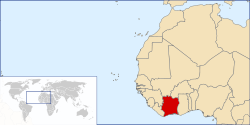 After leaving the fantastical realm of Elyssia, we are heading for more solid ground in the west of Africa. On this beautiful Easter weekend, our small ship sets sail for Cote D’Ivoire on the Gulf of Guinea. Cote D’Ivoire is located in the Gulf between Liberia and Ghana.
After leaving the fantastical realm of Elyssia, we are heading for more solid ground in the west of Africa. On this beautiful Easter weekend, our small ship sets sail for Cote D’Ivoire on the Gulf of Guinea. Cote D’Ivoire is located in the Gulf between Liberia and Ghana.
Home to 20 million people, Cote D’Ivoire became a protectorate of France in 1843 and a colony in 1893 during the “Scramble for Africa”. French slave traders preferred the use of better ports and as such Cote D’Ivoire did not suffer as badly from the slave trade as some of its neighbors. Cote D’Ivoire is regularly called Ivory Coast in western media, however the government discourages this practice.
After their defeat in the Franco-Prussian War, France began to abandon its colonial outposts leaving them in the hands of traders. Cote D’Ivoire won independence in 1960, but maintained close ties with the French. To this day, there is a large population of Ex-pats and foreign workers living in Cote D’Ivoire.
This relationship with France extends so far as to include French and Ivorean peace keeping troops working together to combat rebel groups in the countries north. These close ties with France, as well as working to restructure debts that were incurred while developing the country have helped Cote D’Ivoire to become one of the most successful western African nations. The challenges they face lie in fluctuating world prices on exported agricultural products. The government has made efforts in recent years to diversify their economy to spread this risk.
In recent history, Cote D’Ivoire has experienced iron fisted regimes and political instability. Two coups d’etat in 1999 and 2002 have added to the economic challenges they were already facing. However, thing have begun to improve for Cote D’Ivoire and the future looks more promising.
With agriculture being such a prevalent economic indicator, we can look to the earth for the culinary trends of Cote D’Ivoire. As with many of its neighbors, Ivorean people have relied on subsistence diets throughout much of their history. Dishes are compiled from local produce and are influenced by French traditions.
The national dish of Cote D’Ivoire is FuFu, also known as Mealie Meal Porridge, Pap, Fungee etc. We have seen this staple item before in several forms. It is a porridge made from either white or yellow corn meal that is frequently rolled into balls and eaten slathered in butter. We will not repeat cooking this dish but it is important to note that FuFu is not regularly eaten by itself. Although it is filling nourishment when things are tough, FuFu is generally eaten with a stew made from meats such as chicken or Beef and might include other local products that we have used before such as Palm Oil. Cote D’Ivoire exports Palm oil as one of its many agricultural products. Mixed with onions or Okra and stewed till tender the stews can be ladled over the FuFu or the FuFu can be rolled into balls and coated with butter and eaten as a type of bread. FuFu can also be made from potatoes, yams, cassava or virtually any other starchy flour common to this region.
Here is a link to a previous recipe made with FuFu.



Eric Ackerson is a food writer, blogger and seafood marketing professional. His work takes him to many ports of call around the world. Currently Eric is cooking the national dish of every country on Earth at his blog My Hungry Tum. Eric enjoys travel and says his favorite food cities are Singapore and Vancouver. He lives in Charlotte NC with his wife and two daughters who he says are quickly becoming “foodies” themselves…








